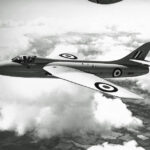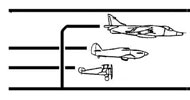| Name: | |
| Gordon Jefferson | |
| Transcript: 8 | |
| Problems with the early Hawker Hunters at Dunsfold | |
When he re-joined Hawkers in 1952 after working at Avro in Canada, Gordon eventually found himself posted to Dunsfold Aerodrome and working on the early Hawker Hunters then in development. The Hunter prototype (the P.1067) had first flown in July 1951 but there were a number of problems with the Mark 1s and Mark 2s – with engines, high altitude gun firing, air brakes and endurance – which prevented the aircraft going into service until 1954. Gordon here describes another problem – how the use of AVTAG jet fuel (as opposed to AVTUR) would cause a fire on the aircraft.So when you went there [at Hawkers] you were originally working as a draughtsman, you seem to have sort of got out of that. Yes I got out of that because I went to Canada. And when I came back from Canada, I was supposed to go and look after airplanes under test at Boscombe Down. But the other bosses in the company didn’t want that, ‘Jefferson chap’ doing that – so what the hell was I going to be given to do? And they had just started at Dunsfold. So I was sent to Dunsfold to ‘keep an eye on things’ and do things like trial installations. And there was plenty of work because there was a lot of development on the Hunter, all the gun firing. The sort of thing that happened was when you fired the guns the airplane fell to bits, because the actual recoil from the four cannon was unbelievable. This is the period when they were really developing, these are the early marks [of the Hawker Hunter] because it actually didn’t come into service for a few years, did it? It was late into service. No, no we were building the production run but we were testing it at the same time really. And there was an enormous amount of work done as a result of the gun firing. And on one occasion we had another problem that is the airplane set on fire and I was given the job of finding out why. And I managed to solve that problem. The reason was that if you fuelled the aircraft with AVTAG, it was so volatile, that we realised, of course, we were losing a certain amount of fuel through the venting system. So what was the expression you used? AVTAG. AVTUR was OK because it was more or less paraffin but if you filled it with AVGAS which is another name for petrol, that was highly volatile and highly inflammable. And as it used to run down the underside of the fuselage from the vents, it got ignited by the jet pipe and that would flash forward and the little pools which were under the engine of course set on fire and set the thing on fire. And because there wasn’t too much there they didn’t burn for that long. But it was a terrible problem when you suddenly find your airplane was on fire. But it didn’t happen if it was AVTUR because it wasn’t volatile enough. And that was just one of the things we worked on. I must admit I can’t remember all the other things we were very busy for a few years sorting all the problems out and of course the production was going on at the same time so modifications were eventually developed and put in the production line at the best opportunity. And then the airplanes had to come back and be modified if necessary.
|
|



